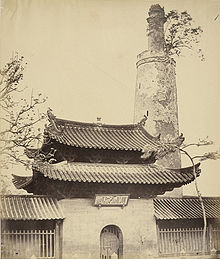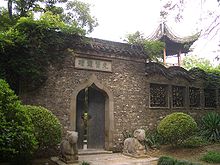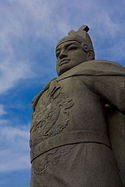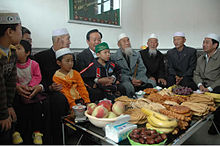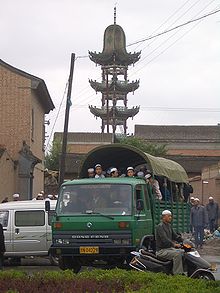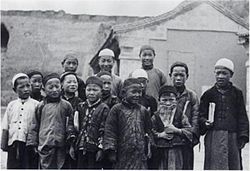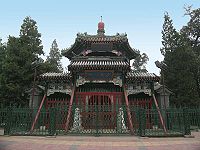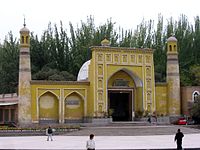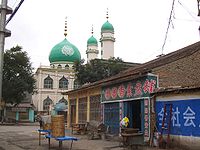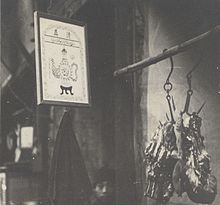- Islam in China
-
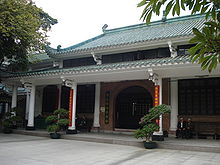 The Huaisheng Mosque is one of the oldest mosques in the world, built by Muhammad's maternal uncle, Sa`d ibn Abi Waqqas
The Huaisheng Mosque is one of the oldest mosques in the world, built by Muhammad's maternal uncle, Sa`d ibn Abi Waqqas
Islam in China  HistoryHistory
HistoryHistory
Tang Dynasty • Song Dynasty
Panthay rebellion • 1911-Present
Yuan Dynasty • Ming Dynasty
Qing Dynasty • Dungan revolts (1862-1877, 1895-1896)Major figuresChang Yuchun • Hu Dahai • Mu Ying • Lan Yu • Yeheidie'erding
Hui Liangyu • Ma Bufang
Ma Hualong
Zheng He • Liu Zhi
Haji Noor • Yusuf Ma DexinThroughout the history of Islam in China, Chinese Muslims have influenced the course of Chinese history.[1] Chinese Muslims have been in China for the last 1,400 years of continuous interaction with Chinese society.[2] Muslims live in every region in China,[3] as China is home to a large population of Muslims.
Contents
History
According to China Muslims' traditional legendary accounts, Islam was first brought to China by Sa'ad ibn abi Waqqas. As reported by Al-Bayhaqi, the Islamic Prophet Muhammad pronounced: "Seek for knowledge even unto China".[4] Chinese Muslims have been in China for the last 1,400 years of continuous interaction with Chinese society.[2]"Islam expanded gradually across the maritime and inland silk routes from the 7th to the 10th centuries through trade and diplomatic exchanges."[5]
Introduction of Islam in 616-18 AD
Islam in China has a rich heritage. Islam was first introduced in China in 616-18 AD by Sahaba (companions) of Muhammad namely Waqqas (Sad ibn abi Waqqas), Sayid, Wahab ibn Abu Kabcha and another Sahaba.[6] Wahab ibn abu Kabcha (Wahb abi Kabcha) might be a son of al-Harth ibn Abdul Uzza (known as Abu Kabsha). See the text: "The Prophet was entrusted to Halimah...Her husband was Al-Harith bin Abdul Uzza called Abi Kabshah, from the same tribe".[7] It is noted in other accounts that Wahab Abu Kabcha reached Canton by sea in 629 CE.
Sa`ad ibn Abi Waqqas along with three Sahabas, namely Thabit ibn Qays, Uwais al-Qarni (594-657), and Hassan ibn Thabit (554-674), went to China from Persia in 637 for the second time and returned by the Yunan-Manipur-Chittagong route, then reached Arabia by sea.[8] Some date the introduction of Islam in China to 650 AD which is the instance of third sojourn of Sad ibn abi Waqqas to China,[9] Sa`ad ibn Abi Waqqas, was sent as an official envoy to Emperor Gaozong which was his third sojourn during Caliph Uthman's era in 651 AD.[10] Throughout the history of Islam in China, Chinese Muslims have influenced the course of Chinese history.
Tang Dynasty
Earlier visits of Sa'd ibn abi Waqqas were noted in Arab accounts since it was a period of nascent Islam mixed with events of many hectic preaching and warfare. They (Sahabas) were more concerned with writings of verses of the Koran as revealed to Muhammad, and his sayings (hadiths) and ways of life (sunnah). According to China Muslims' traditional legendary accounts, Islam was first brought to China by an embassy led by Sa'd ibn abi Waqqas that was sent by Uthman, the third Caliph, (that was in 651, less than twenty years after the death of Muhammad) which are confusions with Sa'd ibn abi Waqqas's earlier visits. The embassy was led by Sa`d ibn Abī Waqqās, the maternal uncle of Muhammad himself. Emperor Gaozong, the Tang emperor who received the envoy then ordered the construction of the Memorial mosque in Canton, the first mosque in the country, in memory of Muhammad.[9][11]
While modern secular historians tend to say that there is no evidence for Waqqās himself ever coming to China,[11] they do believe that Muslim diplomats and merchants came to Tang China within a few decades from the beginning of the Muslim Era.[11] The Tang Dynasty's cosmopolitan culture, with its intensive contacts with Central Asia and its significant communities of (originally non-Muslim) Central and Western Asian merchants resident in Chinese cities, which helped the introduction of Islam.[11] The first major Muslim settlements in China consisted of Arab and Persian merchants.[12] During the Tang and especially the Song eras, comparatively well-established, even if somewhat segregated, mercantile Muslim communities existed in the port cities of Guangzhou, Quanzhou, and Hangzhou on China's southeastern seaboard, as well as in the interior centers such as Chang'an, Kaifeng, and Yangzhou.[13] After critical analysis, it is evident that Sa'd ibn abi Waqqas and the three other Sahabas who were preaching from 616-18 were noticed by Emperor Wu-De by 618 AD. Guangzhou is home to four mosques, including the famous Huaisheng Mosque believed to have been built by Sa`d ibn Abi Waqqas, the uncle of Muhammad. The city also has a grave believed to be that of ibn Abi Waqqas (father of Sa'd ibn abi Waqqas).[14]
Song Dynasty
By the time of the Song Dynasty, Muslims had come to play a major role in the import/export industry.[9][13] The office of Director General of Shipping was consistently held by a Muslim during this period.[15] In 1070, the Song emperor Shenzong invited 5,300 Muslim men from Bukhara, to settle in China in order to create a buffer zone between the Chinese and the Liao empire in the northeast. Later on these men were settled between the Sung capital of Kaifeng and Yenching (modern day Beijing).[16] They were led by Prince Amir Sayyid "So-fei-er" (his Chinese name) who was reputed of being called the "father" of the Muslim community in China. Prior to him Islam was named by the Tang and Song Chinese as Dashi fa ("law of the Arabs").[17] He renamed it to Huihui Jiao ("the Religion of the Huihui").[18]
Tombs of Imam Asim and Mazaar of Zafar Sadiq
"On the foothills of Mount Lingshan are the tombs of two of the four companions that Prophet Muhammad sent eastwards to preach Islam. Known as the "Holy Tombs," they house the companions Sa-Ke-Zu and Wu-Ko-Shun—their Chinese names, of course. The other two companions went to Guangzhou and Yangzhou."[19] "The Imam (Islamic Holy Man) Asim is said to have been one of the first Islamic missionaries in the region. His name is also spelled Imam Hashim (man of c.1000 CE in Hotan). The shrine site includes the reputed tomb of the Imam, a mosque, and several related tombs."[20] There is also a mazaar of Imam Zafar Sadiq.[21]
Yuan Dynasty
During the Mongol-founded Yuan Dynasty (1271–1368), large numbers of Muslims settled in China. The Mongols, a minority in China, gave foreign immigrants, such as Muslims, Christians, and Jews from west Asia an elevated status over the native Han Chinese as part of their governing strategy, thus giving Muslims a heavy influence. Hundreds of thousands of Muslims immigrants were recruited and forcibly relocated from Western and Central Asia by the Mongols to help them administer their rapidly expanding empire.[3] The Mongols used Persian, Arab and Uyghur administrators, generically known as semu [色目]("various eye color")[22] to act as officers of taxation and finance. Muslims headed many corporations in China in the early Yuan period.[23][page needed] Muslim scholars were brought to work on calendar making and astronomy. The architect Yeheidie'erding (Amir al-Din) learned from Han architecture and helped to design the construction of the capital of the Yuan Dynasty, Dadu, otherwise known as Khanbaliq or Khanbaligh, the predecessor of present-day Beijing.[24] The term Hui originated from the Mandarin "Huihui," a term first used in the Yuan Dynasty to describe Central Asian, Persian and Arab residents in China.[11]
Ming Dynasty
During the following Ming Dynasty, Muslims continued to be influential around government circles. Six of Ming Dynasty founder Zhu Yuanzhang's most trusted generals were Muslim, including Lan Yu who, in 1388, led a strong imperial Ming army out of the Great Wall and won a decisive victory over the Mongols in Mongolia, effectively ending the Mongol dream to re-conquer China. Zhu Yuanzhang also wrote a praise of Islam, the The Hundred-word Eulogy. Additionally, the Yongle Emperor hired Zheng He, perhaps the most famous Chinese Muslim and China's foremost explorer, to lead seven expeditions to the Indian Ocean, from 1405 and 1433. However, during the Ming Dynasty, new immigration to China from Muslim countries was restricted in an increasingly isolationist nation. The Muslims in China who were descended from earlier immigration began to assimilate by speaking Chinese dialects and by adopting Chinese names and culture. Mosque architecture began to follow traditional Chinese architecture. This era, sometimes considered the Golden Age of Islam in China,[25] also saw Nanjing become an important center of Islamic study.[26]
Muslims in Ming dynasty Beijing were given relative freedom by the Chinese, with no restrictions placed on their religioius practices or freedom of worship, and being normal citizens in Beijing. In contrast to the freedom granted to muslims, followers of Tibetan Buddhism and Catholicism suffered from restrictions and censure in Beijing.[27]
Qing Dynasty
The Qing Dynasty (1644–1911) witnessed multiple revolts. The Qing rulers belonged to the Manchu, a minority in China. The Muslim revolt in the northwest occurred due to violent and bloody infighting between Muslim sects, the Gedimu, Khafiya, and Jahriyya. The rebellion in Yunnan occurred because of repression by Qing officials, resulting in five bloody Hui rebellions, most notably the Panthay Rebellion, which occurred in Yunnan province from 1855 to 1873, and the Dungan revolt, which occurred mostly in Xinjiang, Shensi and Gansu, from 1862 to 1877. The Manchu government ordered the execution of all rebels, killing a million people in the Panthay rebellion,[28][page needed] several million in the Dungan revolt[28]
The Hui muslim population of Beijing was unaffected by the Muslim rebels during the Dungan revolt.[29]
Elisabeth Allès wrote that the relationship between Hui Muslim and Han peoples continued normally in the Henan area, with no ramifications or consequences from th Muslim rebellions of other areas. Allès wrote "The major Muslim revolts in the middle of the nineteenth century which involved the Hui in Shaanxi, Gansu and Yunnan, as well as the Uyghurs in Xinjiang, do not seem to have had any direct effect on this region of the central plain."[30]
However, many Muslims like Ma Zhan'ao, Ma Anliang, Dong Fuxiang, Ma Qianling, and Ma Julung defected to the Qing dynasty side, and helped the Qing general Zuo Zongtang exterminate the Muslim rebels. These Muslim generals belonged to the Khafiya sect, and they helped Qing massacre Jahariyya rebels. General Zuo moved the Han around Hezhou out of the area and relocated them as a reward for the Muslims there helping Qing kill other Muslim rebels.
In 1895, another Dungan Revolt (1895) broke out, and loyalist Muslims like Dong Fuxiang, Ma Anliang, Ma Guoliang, Ma Fulu, and Ma Fuxiang suppressed and massacred the rebel Muslims led by Ma Dahan, Ma Yonglin, and Ma Wanfu. A Muslim army called the Kansu Braves led by General Dong Fuxiang fought for the Qing dynasty against the foreigners during the Boxer Rebellion. They included well known generals like Ma Anliang, Ma Fulu, and Ma Fuxiang.
In Yunnan, the Qing armies only massacred the Muslims who had rebelled, and spared Muslims who took no part in the uprising.[31]
Republic of China
After the fall of the Qing Dynasty, Sun Yat Sen, who established the Republic of China, immediately proclaimed that the country belonged equally to the Han, Man (Manchu), Meng (Mongol), Hui (Muslim),[n 1] Tsang (Tibetan), and Miao peoples.
During the rule of the Kuomintang party, the Kuomintang appointed the Muslim warlords of the family known as the Ma clique as the Military Governors of the provinces of Qinghai, Gansu and Ningxia. Bai Chongxi was a Muslim General and Defence Minister of China during this time.
People's Republic of China
During the Cultural Revolution, mosques along with other religious buildings were often defaced, destroyed or closed and copies of the Quran were destroyed along with temples, churches, Buddhist and Daoist monasteries, and cemeteries by the Red Guards.[32][page needed] During that time, the government also constantly accused Muslims and other religious groups of holding "superstitious beliefs" and promoting "anti-socialist trends".[33] The government began to relax its policies towards Muslims in 1978. Today, Islam is experiencing a modest revival and there are now [34] many mosques in China. There has been an upsurge in Islamic expression and many nation-wide Islamic associations have been organized to co-ordinate inter-ethnic activities among Muslims.[35]
People
See also: Hui people, Uyghur people, Kazakhs, Dongxiang people, Kyrgyz people, Salar people, Tajiks of Xinjiang, Uzbeks, Bonan, Chinese Tatars, and Tibetan MuslimsEthnic groups
Muslims live in every region in China.[3] The highest concentrations are found in the northwest provinces of Xinjiang, Gansu, and Ningxia, with significant populations also found throughout Yunnan province in southwest China and Henan province in central China.[3] Of China’s 55 officially recognized minority peoples, ten groups are predominantly Muslim. The largest groups in descending order are Hui (9.8 million in year 2000 census, or 48% of the officially tabulated number of Muslims), Uyghur (8.4 million, 41%), Kazakh (1.25 million, 6.1%), Dongxiang (514,000, 2.5%), Kyrgyz (161,000), Salar (105,000), Tajik (41,000), Uzbeks, Bonan (17,000), and Tatar (5,000).[3] However, individual members of traditionally Muslim ethnic groups may profess other religions or none at all. Additionally, Tibetan Muslims are officially classified along with the Tibetan people. Muslims live predominantly in the areas that border Central Asia, Tibet and Mongolia, i.e. Xinjiang, Ningxia, Gansu and Qinghai, which is known as the "Quran Belt".[36]
Number of Muslims in China
China is home to a large population of adherents of Islam. According to the CIA World Factbook, about 1%-2% of the total population in China are Muslims,[37] while the US Department of State's International Religious Freedom Report shows that Muslims constitute about 1.5% of the Chinese population.[38] Recent census counts imply that there may be up to 20 million Muslims in China.[39] A 2009 study done by the Pew Research Center, based on China's census, concluded there are 21,667,000 Muslims in China, accounting for 1.6% of the total population.[40][41][9]
Historical estimates
An early estimate of the Muslim population of the then Qing Empire belongs to the Christian missionary Marshall Broomhall. In his book, published in 1910, he produced estimates for each province, based on the reports of missionaries working there, who had counted mosques, talked to mullahs, etc. Broomhall admits the inadequacy of the data for Xinjiang, estimating the Muslim population of Xinjiang (i.e., virtually the entire population of the province at the time) in the range from 1,000,000 (based on the total population number of 1,200,000 in the contemporary Statesman's Yearbook) to 2,400,000 (2 million "Turki", 200,000 "Hasak", and 200,000 "Tungan", as per George Hunter). He uses the estimates of 2,000,000 to 3,500,000 for Gansu (which then also included today's Ningxia and parts of Qinghai), 500,000 to 1,000,000 for Zhili (i.e., Beijing, Tianjin, and Hebei), 300,000 to 1,000,000 for Yunnan, and smaller numbers for other provinces, down to 1,000 in Fujian. For Mongolia (then, part of the Qing Empire) he takes an arbitrary range of 50,000 to 100,000.[42] Summing up, he arrives to the grand total of 4,727,000 to 9,821,000 Muslims throughout the Qing Empire of its last years, i.e. just over 1-2% of the entire country's estimated population of 426,045,305.[43] [44][45]
Religious practice
Islamic education in China
Over the last twenty years a wide range of Islamic educational opportunities have been developed to meet the needs of China’s Muslim population. In addition to mosque schools, government Islamic colleges, and independent Islamic colleges, a growing number of students have gone overseas to continue their studies at international Islamic universities in Egypt, Syria, Saudi Arabia, Pakistan, Iran, and Malaysia.[3] Qīngzhēn (清真) is the Chinese term for certain Islamic institutions. Its literal meaning is "pure truth."
Muslim groups
The vast majority of China's Muslims are Sunni Muslims. A notable feature of some Muslim communities in China is the presence of female imams.[46] Islamic scholar Ma Tong recorded that the 6,781,500 Hui in China predominately followed the Orthodox form of Islam (58.2 % were Gedimu a non-sufi mainstream tradition that opposed unorthodoxy and religious innovation) mainly adhering to the Hanafi Madh'hab. However a large minority of Hui are members of Sufi groups. According to Tong, 21% Yihewani, 10.9% Jahriyya, 7.2 % Khuffiya, 1.4% Qadariyya, and 0.7 % Kubrawiyya.[47] Shia Chinese Muslims are mostly Ismailis including Tajiks of the Tashkurgan and Sarikul areas of Xingjian.
Chinese Muslims and the Hajj
It is known that Admiral Zheng He (1371–1435) and his Muslim crews had made the journey to Mecca and performed the Hajj during one of the former's voyages to the western ocean between 1401-1433.[48] Other Chinese Muslims may have made the Hajj pilgrimage to Mecca in the centuries followed; however, there is little information on this. The General Ma Lin (warlord), made a Hajj to Mecca.[49] General Ma Fuxiang along with Ma Linyi sponsored Imam Wang Jingzhai when he went on hajj to Mecca in 1921.[50]Yihewani Imam Hu Songshan went on Hajj in 1925.[51] Briefly during the Cultural Revolution, Chinese Muslims were not allowed to attend the Hajj, and only did so through Pakistan, but this policy was reversed in 1979. Chinese Muslims now attend the Hajj in large numbers, typically in organized groups, with a record 10,700 Chinese Muslim pilgrims from all over the country making the Hajj in 2007.[52]
Attitudes toward Non-Muslims
In their early history, Muslims residing in China had closer interactions with adherents of other various faiths. Muslims treated the works of Confucius with considerable respect, pointing out the harmony between the two doctrines.[53] Muslims saw their numbers increase in the 17th century with a large number of Chinese Jews converting to Islam.[53] Muslim General Ma Bufang allowed polytheists to openly worship, and Christian missionaries to station themselves in Qinghai. General Ma and other high ranking Muslim generals even attended the Kokonuur Lake Ceremony where the God of the Lake was worshipped, and during the ritual, the Chinese national anthem was sung, all participants bowed to a portrait of Kuomintang party founder Dr. Sun Zhongshan (Sun Yat Sen), and the God of the Lake was also bowed to, and offerings were given to him by the participants, which included the Muslims.[54] Ma Bufang invited Kazakh Muslims to attend the ceremony honoring the God.[55] Ma Bufang received audiences of Christian missionaries, who sometimes gave him the Gospel.[56] His son Ma Jiyuan received a silver cup from Christian missionaries.[57]
Representative bodies
Islamic Association of China
The Islamic Association of China claims to represent Chinese Muslims nationwide. At its inaugural meeting on May 11, 1953, in Beijing, representatives from 10 nationalities of the People's Republic of China were in attendance.
China Islamic Association
In April 2001, the government set up the China Islamic Association, which was described as aiming to "help the spread of the Qur'an in China and oppose religious extremism". The association is to be run by 16 Islamic religious leaders who are charged with making "a correct and authoritative interpretation" of Islamic creed and canon.
It will compile and spread inspirational speeches and help imams improve themselves, and vet sermons made by clerics around the country. This latter function is probably the key job as far as the central government is concerned. It is worried that some clerics are using their sermons to spread sedition.
Some examples of the religious concessions granted to Muslims are:
- In areas where Muslims are a majority, the breeding of pigs is not allowed, in deference to Muslim sensitivities
- Muslim communities are allowed separate cemeteries
- Muslim couples may have their marriage consecrated by an Imam
- Muslim workers are permitted holidays during major religious festivals
- Chinese Muslims are also allowed to make the Hajj to Mecca, and more than 45,000 Chinese Muslims have done so in recent years.[58]
Culture and heritage
Although contacts and previous conquests have occurred before, the Mongol conquest of the greater part of Eurasia in the 13th century permanently brought the extensive cultural traditions of China, central Asia and western Asia into a single empire, albeit one of separate khanates, for the first time in history. The intimate interaction that resulted is evident in the legacy of both traditions. In China, Islam influenced technology, sciences, philosophy and the arts. In terms of material culture, one finds decorative motifs from central Asian Islamic architecture and calligraphy and the marked halal impact on northern Chinese cuisine.
Taking the Mongol Eurasian empire as a point of departure, the ethnogenesis of the Hui, or Sinophone Muslims, can also be charted through the emergence of distinctly Chinese Muslim traditions in architecture, food, epigraphy and Islamic written culture. This multifaceted cultural heritage continues to the present day.[59]
Military
Muslims have often filled distinguished military positions, and many Muslims have joined the Chinese army.[60] Muslims served extensively in the Chinese military, as both officials and soldiers. It was said that the Muslim Dongxiang and Salar were given to "eating rations", a reference to military service.[61]
Islamic architecture
In Chinese, a mosque is called qīngzhēn sì (清真寺) or "pure truth temple." The Great Mosque of Xi'an (first established during the Tang era) and the Great Southern Mosque in Jinan, whose current buildings date from the Ming Dynasty, do not replicate many of the features often associated with traditional mosques. Instead, they follow traditional Chinese architecture. Mosques in western China incorporate more of the elements seen in mosques in other parts of the world. Western Chinese mosques were more likely to incorporate minarets and domes while eastern Chinese mosques were more likely to look like pagodas.[62]
An important feature in Chinese architecture is its emphasis on symmetry, which connotes a sense of grandeur; this applies to everything from palaces to mosques. One notable exception is in the design of gardens, which tends to be as asymmetrical as possible. Like Chinese scroll paintings, the principle underlying the garden's composition is to create enduring flow; to let the patron wander and enjoy the garden without prescription, as in nature herself.
On the foothills of Mount Lingshan are the tombs of two of the four companions that Muhammad sent eastwards to preach Islam. Known as the "Holy Tombs," they house the companions Sa-Ke-Zu and Wu-Ko-Shun—their Chinese names, of course. The other two companions went to Guangzhou and Yangzhou.[63]
Chinese buildings may be built with bricks, but wooden structures are the most common; these are more capable of withstanding earthquakes, but are vulnerable to fire. The roof of a typical Chinese building is curved; there are strict classifications of gable types, comparable with the classical orders of European columns.
As in all regions the Chinese Islamic architecture reflects the local architecture in its style. China is renowned for its beautiful mosques, which resemble temples. However, in western China the mosques resemble those of the middle east, with tall, slender minarets, curvy arches and dome shaped roofs. In northwest China where the Chinese Hui have built their mosques, there is a combination of east and west. The mosques have flared Chinese-style roofs set in walled courtyards entered through archways with miniature domes and minarets.[62] The first mosque was the Great Mosque of Xian, or the Xian Mosque, which was created in the Tang Dynasty in the 7th century.[64]
Halal food in China
Due to the large Muslim population in western China, many Chinese restaurants cater to Muslims or cater to the general public but are run by Muslims. In most major cities in China, there are small Islamic restaurants or food stalls typically run by migrants from Western China (e.g., Uyghurs), which offer inexpensive noodle soup. Lamb and mutton dishes are more commonly available than in other Chinese restaurants, due to the greater prevalence of these meats in the cuisine of western Chinese regions. Commercially prepared food can be certified Halal by approved agencies. [65] In Chinese, halal is called qīngzhēn cài (清真菜) or "pure truth food."
Islamic Finance
China and Chinese Muslim economists have a long tradition with Islamic finance. The latest official attempt is Bank of Ningxia; while Hong Kong as financial center is discussing intensively its role.[66]
Calligraphy
Sini
Sini is a Chinese Islamic calligraphic form for the Arabic script. It can refer to any type of Chinese Islamic calligraphy, but is commonly used to refer to one with thick and tapered effects, much like Chinese calligraphy. It is used extensively in mosques in eastern China, and to a lesser extent in Gansu, Ningxia, and Shaanxi. A famous Sini calligrapher is Hajji Noor Deen Mi Guangjiang.
Xiao'erjing
Xiao'erjing (also Xiao'erjin or Xiaojing) is the practice of writing Sinitic languages such as Mandarin (especially the Lanyin, Zhongyuan, and Northeastern dialects) or the Dungan language in the Arabic script. It is used on occasion by many ethnic minorities who adhere to the Islamic faith in China (mostly the Hui, but also the Dongxiang, and the Salar), and formerly by their Dungan descendants in Central Asia.
Martial arts
Muslim development and participation at the highest level of Chinese wushu has a long history. Many of its roots lie in the Qing Dynasty persecution of Muslims. The Hui started and adapted many of the styles of wushu such as bajiquan, piguazhang, and liuhequan. There were specific areas that were known to be centers of Muslim wushu, such as Cang County in Hebei Province. These traditional Hui martial arts were very distinct from the Turkic styles practiced in Xinjiang.[67]
Literature
The Han Kitab was a collection of Chinese Islamic texts written by Chinese Muslim which synthesized Islam and Confucianism. It was written in the early 18th century during the Qing dynasty. Han is Chinese for Chinese, and kitab (ketabu in Chinese) is Arabic for book.[68] Liu Zhi wrote his Han Kitab in Nanjing in the early 18th century. The works of Wu Sunqie, Zhang Zhong, and Wang Daiyu were also uncluded in the Han Kitab.[69]
The Han Kitab was widely read and approved of by later Chinese Muslims such as Ma Qixi, Ma Fuxiang, and Hu Songshan. They believed that Islam could be understood through Confucianism.
Education
For some Muslim groups in China, such as Hui and Salars minorities, coeducation is frown upon; for some groups such as Uyghurs, its not.[70]
Famous Muslims in China
Explorers
Military
- Founding generals of the Ming dynasty: Hu Dahai, Lan Yu, Mu Ying
- The leaders of the Panthay Rebellion in Yunnan and the Muslim Rebellion in Northwestern China: Du Wenxiu, Ma Hualong, Ma Zhan'ao
- Chang Yuchun Ming Dynasty General
- Dong Fuxiang Qing Dynasty General
- Liu Bin Di was a Hui Kuomintang officer who died while fighting against Uyghur rebels in the Ili Rebellion.
- Ma Julung Qing Dynasty General
- The Ma clique of warlords during the Republic of China era: Ma Bufang, Ma Chung-ying, Ma Fuxiang, Ma Hongkui, Ma Dunjing (1910-2003), Ma Hongbin, Ma Dunjing (1906-1972), Ma Lin, Ma Qi, Ma Hu-shan, Ma Zhan'ao, Ma Qianling, Ma Fushou, Ma Fulu, Ma Anliang, Ma Guoliang, Ma Buqing, Ma Bukang, Ma Jiyuan, Ma Chengxiang, Ma Haiyan
- Ma Zhancang, general in the Republic of China army
- Ma Zhanshan, guerilla warrior against the Japanese during the Second Sino-Japanese War
- Ma Fuyuan, general in the Republic of China army
- Ma Ju-lung Republic of China general
- Ma Sheng-kuei, a general of the 36th Division (National Revolutionary Army)
- Ma Xiao, Republic of China general in Liu Wenhui's army
- Ma Xinyi, official and a military general of the late Qing Dynasty in China.
- Ma Zhanhai Republic of China general
- Su Chin-shou,a general of the 36th Division (National Revolutionary Army)
- Bai Chongxi, general in the Republic of China army
- Pai Tzu-li, a general of the 36th Division (National Revolutionary Army)
- Ma Ching-chiang, Lt. General of the Republic of China Army
- Ma Shenglin, rebel during the Panthay Rebellion, great uncle of Ma Shaowu
- Zuo Baogui (左寶貴) (1837–1894), Qing Muslim general from Shandong province, was martyred in Pingyang in Korea by Japanese cannonfire in 1894 while defending the city. A memorial to him was built.[71]
Religious
- Liu Zhi (ca. 1660 - ca. 1739), Qing Dynasty Islamic author
- Qi Jingyi (1656–1719), a Sufi master who introduced the Qadiriyyah school into China
- Ma Laichi (1681?-1766?), a Sufi master, who brought the Khufiyya Naqshbandi movement to China
- Ma Mingxin (1719–1781), the founder of the Jahriyya Naqshbandi movement
- Ma Wanfu, founder of the Yihewani
- Ma Qixi(1857–1914), founder of the Xidaotang
- Ma Yuanzhang, Jahriyya Sufi leader
- Hu Songshan (1880–1956), Yihewani reformer, and Chinese nationalist
Scholars and writers
- Bai Shouyi, historian
- Tohti Tunyaz, historian
- Yusuf Ma Dexin, first translator of the Qur'an into Chinese
- Muhammad Ma Jian, author of the most popular Chinese translation of the Qur'an
- Wang Daiyu, Master Supervisor of the Imperial Observatory during the Ming Dynasty. He was called ‘Master of the Four Religions’ because of his complete knowledge of China’s four religions: Islam, Buddhism, Taoism and Confucianism.[72]
- Zhang Chengzhi, contemporary author
- Ma Linyi Gansu Minister of Education
- Pai Hsien-yung, contemporary author, son of Bai Chongxi
Martial arts
- Ma Xianda, martial artist.
- Wang Zi-Ping, member of an underground revolutionary group known as "The Righteous and Harmonious Fists" during the Boxer Rebellion.
- Chang Tung Sheng, martial artist and Shuai jiao teacher.
In politics
Highest ranking Muslim official in the People's Republic of China
- Hui Liangyu, vice premier in charge of agriculture in the People's Republic of China
Other
- Noor Deen Mi Guangjiang, calligrapher
See also
- The Hundred-word Eulogy
- Chinese Muslim cuisine
- Islam by country
- Religion in China
- Demographics of the People's Republic of China
- Christianity in China
Footnotes
- ^ currently, "Hui" in Chinese means both Islam and ethnic Hui Chinese, but back then, Hui meant Islam and all Chinese Muslims, particularly both ethnic Hui and Uyghurs
Notes
- ^ Bentley, Jerry H.; Ziegler, Herbert (2007). Traditions and Encounters: A Global Perspective on the Past. McGraw-Hill. p. 586. ISBN 0073406937.
- ^ a b Dru C. Gladney writes http://journals.cambridge.org/action/displayAbstract?fromPage=online&aid=164869
- ^ a b c d e f Armijo 2006
- ^ Ali al-Muttaqi, 1958, Kanz al-Ummal, vol.5, Hyderabad (India), p. 202.
- ^ Dru C. Gladney wrote books.google.co.in/books?isbn=1850653240
- ^ Dru C. Gladney, Muslim Tombs & Ethnic Folklore-Hui Identity, in The Journal of Asian Studies, California, vol.16, No.3, Aug. 1987, p. 498, p. 498 nt.8.
- ^ Safi-ur Rahman Al-Mubarakpuri, 2009, Ar-Raheeq al-Makhtum: The Sealed Nectar: Biography of the Noble Prophet, Madinah: Islamic University of Al-Madinah al-Munawwarah, page 72.
- ^ Maazars in China-www.aulia-e-hind.com/dargah/Intl/Chin
- ^ a b c d BBC 2002, Origins
- ^ Abul-Fazl Ezzati, 1994, The Spread of Islam, Tehran: Ahlul Bayt World Assembly Publications, pp. 300,303, 333.
- ^ a b c d e Lipman 1997, p. 25
- ^ Israeli 2002, p. 291
- ^ a b Lipman 1997, pp. 26–27
- ^ http://www.halaljournal.com/article/2829/traders-revive-islam-in-china
- ^ Ting 1958, p. 346
- ^ Israeli 2002, pp. 283–4
- ^ Israeli 2002, p. 283; Tashi or Dashi is the Chinese rendering of Tazi—the name the Persians used for the Arabs
- ^ Israeli 2002, p. 284
- ^ http://www.islamonline.net/servlet/Satellite?c=Article_C&cid=1158658465259&pagename=Zone-English-ArtCulture%2FACELayout
- ^ http://wikimapia.org/9992600/Imam-Asim-Shrine-and-Ancient-Tomb
- ^ http://www.centralasiatraveler.com/cn/xj/nm/niya-minfeng.html%22%3ENiya
- ^ Lipman 1997, p. 33
- ^ Bulliet et al. 2005
- ^ The Hui ethnic minority, People's Daily, http://english.peopledaily.com.cn/data/minorities/Hui.html, retrieved 2010-09-19
- ^ Ting 1958, p. 350
- ^ Dillon 1999, p. 37
- ^ Susan Naquin (2000). Peking: temples and city life, 1400-1900. University of California Press. p. 214. ISBN 0520219910. http://books.google.com/books?id=bANasl7nayUC&pg=PA214&dq=whether+natives+of+central+asia+or+of+north+china,+muslim+converts+did+not+suffer+the+same+religious+strictures+as+tibetan+buddhist+or+european+catholics.+they+could+and+did+practice+their+religion+as+they+pleased+and+live+at+large+as+ordinary+members+of+peking+society.&hl=en&ei=0DImTrSlCdTAgQecscxc&sa=X&oi=book_result&ct=result&resnum=1&ved=0CCkQ6AEwAA#v=onepage&q&f=false. Retrieved 2010-11-28.
- ^ a b Gernet 1996
- ^ Hugh D. R. Baker (1990). Hong Kong images: people and animals. Hong Kong University Press. p. 55. ISBN 9622092551. http://books.google.com/books?id=6SACPP8mZQ8C&pg=PA55&dq=yet+while+this+slaughter+was+going+on,+we+are+told,+200,000+muslims+in+beijing+remained+quite+unaffected,+neither+giving+nor+suffering+any+trouble&hl=en&ei=NTUmTtHUCIXpgQfe69Vc&sa=X&oi=book_result&ct=result&resnum=1&ved=0CCkQ6AEwAA#v=onepage&q=yet%20while%20this%20slaughter%20was%20going%20on%2C%20we%20are%20told%2C%20200%2C000%20muslims%20in%20beijing%20remained%20quite%20unaffected%2C%20neither%20giving%20nor%20suffering%20any%20trouble&f=false. Retrieved 2011-6-19.
- ^ Allès, Elizabeth (september-october 2003, Online since 17 january 2007). "Notes on some joking relationships between Hui and Han villages in Henan". French Centre for Research on Contemporary China. p. 6. http://chinaperspectives.revues.org/document649.html. Retrieved 2011-07-20.
- ^ Dillon 1999, p. 77
- ^ Goldman 1986
- ^ Israeli (2002), pg. 253
- ^ Mosques (Masjid) in China
- ^ BBC 2002, China today
- ^ Barnett 1963, p. 183
- ^ CIA - The World Factbook - China
- ^ China (includes Hong Kong, Macau, and Tibet)
- ^ Counting up the number of people of traditionally Muslim nationalities who were enumerated in the 1990 census gives a total of 17.6 million, 96% of whom belong to just three nationalities: Hui 8.6 million, Uyghurs 7.2 million, and Kazakhs 1.1 million. Other nationalities that are traditionally Muslim include Kyrghyz, Tajiks, Uzbeks, Tatars, Salar, Bonan, and Dongxiang. See Dru C. Gladney, "Islam in China: Accommodation or Separatism?", Paper presented at Symposium on Islam in Southeast Asia and China, Hong Kong, 2002. Available at http://www.islamsymposium.cityu.edu.hk. The 2000 census reported a total of 20.3 million members of Muslim nationalities, of which again 96% belonged to just three groups: Hui 9.8 million, Uyghurs 8.4 million, and Kazakhs 1.25 million.
- ^ "Mapping the Global Muslim Population." Pew Research Center. October 2009. See pages 13 and 45.
- ^ Secrets of Islam, U.S. News & World Report. Information provided by the International Population Center, Department of Geography, San Diego State University (2005).
- ^ Broomhall 1910, p. 214 Quote: "No definite information has been received concerning Mongolia".
- ^ Broomhall 1910, pp. 196–215
- ^ Broomhall 1910, pp. 216–217
- ^ Ferm 1976, p. 145
- ^ "Chinese Muslims forge isolated path", BBC News, 2004-09-15, http://news.bbc.co.uk/2/hi/asia-pacific/3656180.stm, retrieved 2008-08-05
- ^ Esposito 1999, p. 458
- ^ Mohammed Rasooldeen; Ali Al-Zahrani (2006-07-06), Legacy of Chinese Muslim Mariner Relived, http://www.arabnews.com/?page=1§ion=0&article=84932&d=6&m=7&y=2006&pix=kingdom.jpg&category=Kingdom, retrieved 2010-09-19
- ^ Ethnicity and Politics in Republican China: The Ma Family Warlords of Gansu
- ^ Dudoignon, Komatsu & Kosugi 2006, p. 315
- ^ Lipman 1997, p. 209
- ^ A record 10,700 Chinese Muslims to perform Hajj, Kingdom of Saudi Arabia: Ministry of Hajj, 2007-11-15, http://www.hajinformation.com/main/y1558.htm, retrieved 2010-09-19
- ^ a b [http://books.google.com/books?id=O45CAAAAIAAJ&pg=PR15&dq=spread+of+islam+thomas+walker&hl=en&ei=u9T2TPafLIL-8Ab2mLiWBw&sa=X&oi=book_result&ct=result&resnum=2&ved=0CCsQ6AEwAQ#v=onepage&q&f=false The preaching of Islam: a history of the propagation of the Muslim faith By Sir Thomas Walker Arnold, pg.249-253
- ^ Bulag 2002, p. 51
- ^ Bulag 2002, p. 52
- ^ American Water Works Association (1947). Journal of the American Water Works Association, Volume 39, Part 1. The Association. p. 24. http://books.google.com/books?id=NrtBAAAAYAAJ&q=ma+pu-fang+gospel&dq=ma+pu-fang+gospel&hl=en&ei=0wSZTOywNYH_8AaOw-X0Dw&sa=X&oi=book_result&ct=result&resnum=1&ved=0CC8Q6AEwAA. Retrieved 2010-06-28.
- ^ HORLEMANN, BIANCA. "The Divine Word Missionaries in Gansu, Qinghai and Xinjiang, 1922–1953: A Bibliographic Note". http://journals.cambridge.org/action/displayAbstract?fromPage=online&aid=5858164. Retrieved 2010-06-28.
- ^ BBC 2002, China Islamic Association
- ^ CHINA HERITAGE NEWSLETTER China Heritage Project, The Australian National University ISBN 1833-8461 No. 5, March 2006
- ^ James Hastings, John Alexander Selbie, Louis Herbert Gray (1916). Encyclopædia of religion and ethics, Volume 8. T. & T. Clark. p. 893. http://books.google.com/books?id=eEwTAAAAYAAJ&pg=PA893&dq=On+the+other+hand,+the+most+capable+and+energetio+of+them+were+doubtless+able+to+fulfil+the+conditions+of+entrance+into+the+Chinese+army,+and+to+work+their+way+to+the+higher+ranks.+From+the+Mongolian+period+onwards+Muslims+have+often+filled+the+more+distinguished+military+positions.+As+recent+instances+of+this,+mention+may+be+made+of+General+Tung-fu-hsiang+(see+below+(a)),+as+well+as+of+Ma-ti-kai,+of+Yun-nan,+nephew+of+Ma-hua-lung,+and+commander-general+of+the+forces+in+Sze-chuan.&hl=en&ei=TOYIToCrM4XUgQeXtcy3DQ&sa=X&oi=book_result&ct=result&resnum=1&ved=0CCwQ6AEwAA#v=onepage&q=On%20the%20other%20hand%2C%20the%20most%20capable%20and%20energetio%20of%20them%20were%20doubtless%20able%20to%20fulfil%20the%20conditions%20of%20entrance%20into%20the%20Chinese%20army%2C%20and%20to%20work%20their%20way%20to%20the%20higher%20ranks.%20From%20the%20Mongolian%20period%20onwards%20Muslims%20have%20often%20filled%20the%20more%20distinguished%20military%20positions.%20As%20recent%20instances%20of%20this%2C%20mention%20may%20be%20made%20of%20General%20Tung-fu-hsiang%20(see%20below%20(a))%2C%20as%20well%20as%20of%20Ma-ti-kai%2C%20of%20Yun-nan%2C%20nephew%20of%20Ma-hua-lung%2C%20and%20commander-general%20of%20the%20forces%20in%20Sze-chuan.&f=false. Retrieved 2010-11-28.
- ^ Christian Literature Society for India, Hartford Seminary Foundation (1920). Samuel Marinus Zwemer. ed. The Moslem World, Volume 10. Hartford Seminary Foundation. p. 379. http://books.google.com/books?id=u5soAAAAYAAJ&pg=PA378&dq=ma+an-liang+died+november&hl=en&ei=7mPsTdSBIIL50gG7p8TDAQ&sa=X&oi=book_result&ct=result&resnum=3&ved=0CDsQ6AEwAg#v=snippet&q=salars%20%20tunghsiang%20eating%20rations%20military&f=false. Retrieved 2011-06-06.
- ^ a b Cowen, Jill S. (July/August 1985), "Muslims in China: The Mosque", Saudi Aramco World: 30–35, http://www.saudiaramcoworld.com/issue/198504/muslims.in.china-the.mosques.htm, retrieved 2006-04-08
- ^ The Muslim History of China
- ^ China By Shelley Jiang,pg. 274
- ^ Halal Food
- ^ Islamic Finance in China<
- ^ NTU Bajiquan Kungfu Club http://club.ntu.edu.tw/~ntubachi/Bajiquan/en_about.htm
- ^ Dillon 1999, p. 104
- ^ Jonathan Neaman Lipman (2004). Familiar strangers: a history of Muslims in Northwest China. Seattle: University of Washington Press. p. 79. ISBN 9050295976446. http://books.google.com/books?id=90CN0vtxdY0C&pg=PA191. Retrieved 2010-06-28.
- ^ Ruth Hayhoe (1996). China's universities, 1895-1995: a century of cultural conflict. Taylor & Francis. p. 202. ISBN 0815318596. http://books.google.com/books?id=5bsZxAhzxk0C&pg=PA211&dq=sala+hui&hl=en&ei=TBXDTLKTE8P6lwe-g_kF&sa=X&oi=book_result&ct=result&resnum=9&ved=0CFMQ6AEwCDgU#v=snippet&q=sala%20hui%20muslim%20girls%20coeducation%20uighur%20no%20problem%20frowned&f=false. Retrieved 2010-06-29.
- ^ Aliya Ma Lynn (2007). Muslims in China. University Press. p. 44. ISBN 0880938617. http://books.google.com/books?id=s4Lp8tgr3esC&dq=ma+wanfu+exile+xinjiang&q=ma+fuxiang#v=onepage&q=zuo%20baogui%20killed%20sino-japanese%20war&f=false. Retrieved 2010-06-28.
- ^ British and Muslim?
 This article incorporates text from The Moslem World, Volume 10, by Christian Literature Society for India, Hartford Seminary Foundation, a publication from 1920 now in the public domain in the United States.
This article incorporates text from The Moslem World, Volume 10, by Christian Literature Society for India, Hartford Seminary Foundation, a publication from 1920 now in the public domain in the United States. This article incorporates text from Encyclopædia of religion and ethics, Volume 8, by James Hastings, John Alexander Selbie, Louis Herbert Gray, a publication from 1916 now in the public domain in the United States.
This article incorporates text from Encyclopædia of religion and ethics, Volume 8, by James Hastings, John Alexander Selbie, Louis Herbert Gray, a publication from 1916 now in the public domain in the United States.
References
- Broomhall, Marshall (1910), Islam in China: a neglected problem, China Inland Mission, OCLC 347514, http://books.google.com/books?id=ObcNAAAAIAAJ. A 1966 reprint by Paragon Book Reprint is available; written with a strong Christian missionary point of view, but contains valuable first-hand evidence and photographs.
- Keim, Jean (1954), "Les Musulmans Chinois", France-Asie 10, OCLC 457005588
- Ting, Dawood C. M. (1958), "Chapter 9: Islamic Culture in China", in Morgan, Kenneth W., Islam—The Straight Path: Islam Interpreted by Muslims, New York: The Ronald Press Company, pp. 344–374, OCLC 378570, http://www.religion-online.org/showchapter.asp?title=1656&C=1645
- Reischauer, Edwin O.; Fairbank, John K. (1960), East Asia: The Great Tradition, Houghton Mifflin, OCLC 994133
- Barnett, A. Doak (1963), China on the Eve of Communist Takeover, Praeger publications in Russian history and world communism, 130, New York: Praeger, OCLC 412125
- Ferm, Vergilius, ed. (1976), An Encyclopedia of Religion (reprinted ed.), Westport, CT: Greenwood Press, ISBN 9780837186382; first published as Ferm, ed. (1945), New York: Philosophical Library, OCLC 263969. 1976 reprint is unrevised.
- American Water Works Association (1947), Journal of the American Water Works Association, Volume 39, Part 1, The Association
- Fairbank, John King; Liu, Kwang-ching; Twitchett (1980), Late Ch'ing, 1800-1911, Cambridge University Press, ISBN 0521220297
- Goldman, Merle (1986), "Religion in Post-Mao China", The Annals of the American Academy of Politica and Social Science 483 (1): 146–156, doi:10.1177/0002716286483001013
- Gernet, Jacques (1996), A History of Chinese Civilization (2nd ed.), New York: Cambridge University Press, ISBN 0-521-49712-4
- Lipman, Jonathan Newman (1997), Familiar Strangers, a history of Muslims in Northwest China, Seattle, WA: University of Washington Press, ISBN 0-295-97644-6
- Esposito, John L. (1999), The Oxford history of Islam, United States of America: Oxford University Press, ISBN 00195107993
- Dillon, Michael (1999), China's Muslim Hui Community, Curzon, ISBN 0-7007-1026-4
- Gillette, Maris Boyd (2000), Between Mecca and Beijing: modernization and consumption among urban Chinese Muslims, Stanford University Press, ISBN 0804736944
- Uradyn Erden Bulag (2002), Dilemmas The Mongols at China's edge: history and the politics of national unity, Rowman & Littlefield, ISBN 0742511448
- Rubin, Barry (2000), Guide to Islamist Movements, M.E. Sharpe, ISBN 0765617471
- Israeli, Raphael (2002), Islam in China, United States of America: Lexington Books, ISBN 0-7391-0375-X
- Islam in China (650-present), Religion and Ethics, BBC, 2002, http://www.bbc.co.uk/religion/religions/islam/history/china_1.shtml, retrieved 2010-03-15
- Bulliet, Richard; Crossley, Pamela; Headrick, Daniel; Hirsch, Steven; Johnson, Lyman; Northrup, David (2005), The Earth and Its Peoples, Boston: Houghton Mifflin, ISBN 0-618-42770-8
- Levene, Mark (2005), Genocide in the Age of the Nation-State, I. B.Tauris, ISBN 1-84511-057-9
- Stéphane A. Dudoignon, Hisao Komatsu, Yasushi Kosugi (2006), Intellectuals in the modern Islamic world: transmission, transformation, communication, Taylor & Francis, ISBN 00415368359
- Armijo, Jackie (2006), "Islamic Education in China", Harvard Asia Quarterly 10 (1), archived from the original on 2007-09-28, http://web.archive.org/web/20070928055702/http://www.asiaquarterly.com/content/view/166/43
- Giersch, Charles Patterson (2006), Asian Borderlands: The Transformation of Qing China's Yunnan Frontier, Harvard University Press, ISBN 1-84511-057-9
- Islam in China, Hui and Uyghurs: between modernization and sinicization, the study of the Hui and Uyghurs of China, Jean A. Berlie, White Lotus Press editor, Bangkok, Thailand, published in 2004. ISBN 9744800623, 9789744800626.
External links
- Asia Times Online: China News - Islam with Chinese characteristics
- Islam in China
- Islam in China
- Photos of "Islam in China" by Photojournalist Sean Gallagher
- The New York times
- islamawareness.net
- www.islamcn.net
- Islamic Chinese Art (Dru C. Gladney's photo album on Flickr.com)
- Islamic Architecture in China with lots of photographs
- International Imam Organization
Islam in Asia Sovereign
states- Afghanistan
- Armenia
- Azerbaijan
- Bahrain
- Bangladesh
- Bhutan
- Brunei
- Burma (Myanmar)
- Cambodia
- People's Republic of China
- Cyprus
- East Timor (Timor-Leste)
- Egypt
- Georgia
- India
- Indonesia
- Iran
- Iraq
- Israel
- Japan
- Jordan
- Kazakhstan
- North Korea
- South Korea
- Kuwait
- Kyrgyzstan
- Laos
- Lebanon
- Malaysia
- Maldives
- Mongolia
- Nepal
- Oman
- Pakistan
- Philippines
- Qatar
- Russia
- Saudi Arabia
- Singapore
- Sri Lanka
- Syria
- Tajikistan
- Thailand
- Turkey
- Turkmenistan
- United Arab Emirates
- Uzbekistan
- Vietnam
- Yemen
States with limited
recognition- Abkhazia
- Nagorno-Karabakh
- Northern Cyprus
- Palestine
- Republic of China (Taiwan)
- South Ossetia
Dependencies and
other territories- Christmas Island
- Cocos (Keeling) Islands
- Hong Kong
- Macau
 This article incorporates text from Encyclopædia of religion and ethics, Volume 8, a publication from 1916 now in the public domain in the United States.
This article incorporates text from Encyclopædia of religion and ethics, Volume 8, a publication from 1916 now in the public domain in the United States. This article incorporates text from The Moslem World, Volume 10, a publication from 1920 now in the public domain in the United States.Categories:
This article incorporates text from The Moslem World, Volume 10, a publication from 1920 now in the public domain in the United States.Categories:- Islam in China
- Chinese culture
- Religion in the People's Republic of China
Wikimedia Foundation. 2010.


